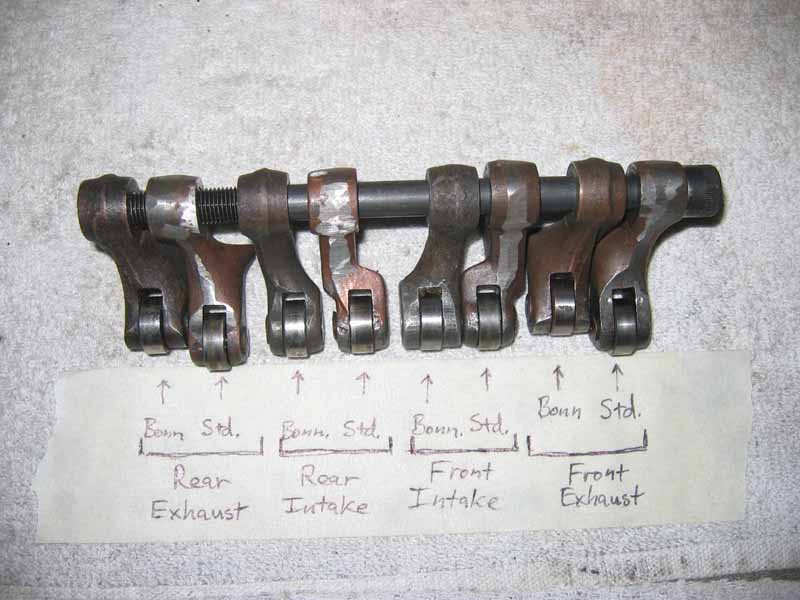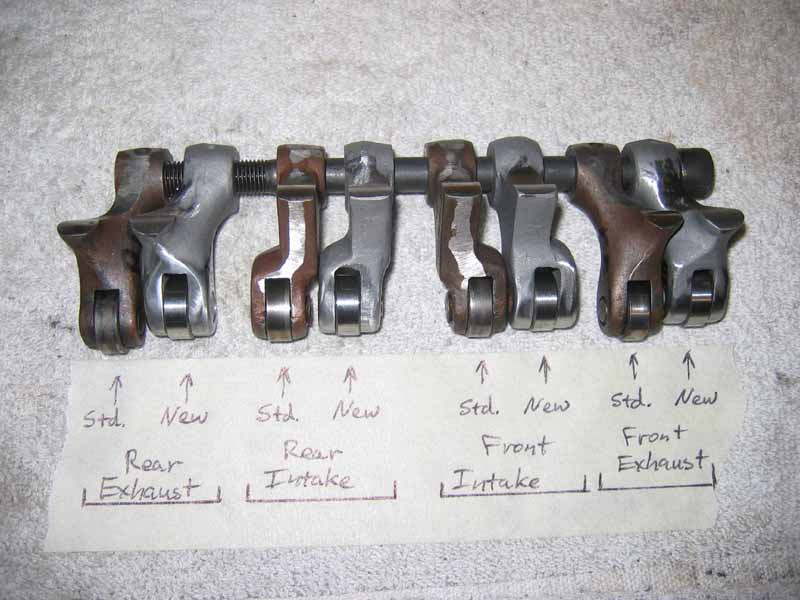Avoiding Scout Bonneville Cams and Lifters
In 1939 Indian went to Bonneville to set some speed records with both Chiefs, and Scouts. They then came out with both Scout, and Chief production "Bonneville" models to commemorate their success. They were made in limited production, and the Scout "Bonneville" version was available from 1939 through 1942 at the end of Scout production. The Chief "Bonneville" version was available from 1939 through 1948 in the 74 inch motor size, and later used in all 80 inch motors from 1950 through 1953 (although it has been said that the '52 and '53 chiefs used standard lifters with the Bonneville lobes-WHY?). Both the Scout, and Chief "Bonneville" versions came with longer duration cams, higher lift (in the Chief only), magneto ignitions, higher compression by using taller pistons, and special flycut heads. The "Bonnevilles" definitely run better than standard models. The Indian techs for some unknown reason didn't apply the same design theory to the Scout as they did the Chief. They did the Chief upgrade very well considering the technology of the day. The Chief cam duration was increased to a modern mild equivelant, keeping the lobe centers centered (not advanced). Scouts have (4) seperate lifters, while the Chief use (2) identical pairs of lifters (male, and female pairs). On the Chief they moved the rollers inward toward the pivot pins an equal amount by 10 degrees of crank rotation. In other words, the roller axle distance to the pivot pin on all (4) Chief lifters are the same, whether using standard lifters, or Bonneville lifters, except that the Bonneville lifters have the rollers location moved 10 degrees closer to the pivot pins. Scout on the other hand had a wide variety of roller axle to pivot pin locations based on the specific model (year model) of Scout. The Chief standard lifters have a built-in lobe center distance of 115 degrees (poor for performance), and by moving the rollers inward, the new lobe center location for Bonneville lifters became 105 degrees, which is a very good number for mild performance cams. The Chief Bonneville cam/lifter package was well thought out! Scouts were handled very differently. The Scout intake, and exhaust lifter roller axle to pivot pin distances were never exactly the same, and the Bonneville model showed a radical distance change done incorrectly in my opinion.
Since the roller axle center to the pivot pin distance of a lifter directly controls that lifters lobe center line, the lobe center numbers are all over the place. An ideal lobe center location for a mild cam is at or near 105 degrees for both intake, as well as exhaust. If a cam is slightly advanced from "straight up" lobe centers, for example a (2) degree advance, then that 105 degree cam becomes a 103/107 degree lobe center cam for intake/exhaust (still good numbers). Scout cam lobes sometimes were adjusted off center on their gear to try to correct for goofy lobe center numbers generated by improper design of roller axle to pivot pin center distances. A characteristic of different roller axle to pivot pin distance is a change in rocker arm ratio for a given lifter. Since the push rod pad on the lifter needs to always remain in the same place (distance from the pivot pin), a longer arm to the roller axle will yield a lesser rocker arm ratio, and a shorter arm yields a greater rocker ratio. The rocker ratio is multiplied against the cam lobe lift to find the actual valve lift. Therefore moving the rollers inward will increase the rocker ratio, which will in turn increase valve lift for a given cam lobe profile. In the Chief motor, a standard lifter on a Bonneville cam yields around .380" lift, where the Bonneville lifters will yield around .410" lift due to the increased rocker ratio.
All modern motors use a larger intake valve than the exhaust valve, but Indians always used the same size valve for intake, and exhaust (2" for Chief, and 1 3/4" for Scouts). If they were going to play with roller axle to pivot pin distances, to create different rocker ratios so that they could show a higher lift for intake as opposed to exhaust, then they would have needed to make lifters where the intake roller was more inward than the exhaust roller. The Chief was the same in design from intake to exhaust, which is just fine, but the Scout was treated differently. The Scout standard lifters, indeed, had longer exhaust lifters than intakes, which would give a higher rocker ratio for the intakes slightly. But when it came time to modify the lifters for the Scout Bonneville package, they didn't move both rollers inward appropriately, they moved the exhaust roller in a bunch, and left the intake roller location the same as standard lifters (actually just slightly shorter than standard lifters). They then designed a cam lobe with more duration, but due to the intake lifter lobe center remaining the same as a standard Scout, and by radicilly relocating the exhaust lifter lobe center only, they shifted (advanced) the cam lobe center on the gear a bunch to offset the exhaust lobe center, so they would end up with an intake/exhaust lobe center that was useable. There are several flaws in this setup. First, by radically shortening just the exhaust lifter, the exhaust rocker ratio is much higher than the intakes (it should be the other way around!). For some unknown reason, the factory modified the lifter's push rod pad by grinding it down to alter the pushrod contact point to try to reduce the increase in rocker ratio. It makes for a funky push rod contact point on the pad as well. By doing this, they were able to keep the intake, and exhaust valve lifts the same, which is actually the same as the standard Scout (not good!) Another problem is that the shorter the roller distance of a lifter, the worse the roller contact point to the cam's base circle exists (this really screws up the cam geometry!). They should have made the intake, and exhaust lifters roller axle to pivot pin distances the same, and then place the cam lobe accordingly. My new Scout racing lifters are both the same distance (like Chiefs)!
Here is some measured Scout cam data: I measured a standard Sport Scout set of cams, and lifters, and found that when measured from .050" valve lift locations, that the intakes were 199 degrees duration, and the lobe centers were at 117.5 degrees, while the exhaust duration was 200 degrees, and the lobe centers were at 116 degrees. This cam is running 3/4 degrees retarded (perfect for your lawn mower). Next, I measured an NOS set of Bonneville cams, and lifters from Bob Stark's inventory, and I was horrified at the results. I found the intake and exhaust durations to be 224/226 degrees measured at the .050" locations (similar to the Chief Bonneville), with the lobe centers at 113 for the intake, and at 93 for the exhaust. I noticed that the intake roller was just slightly closer to the pivot pin than a standard Sport Scout lifter, which would account for the decrease from 117.5 to 113 degree lobe center. The exhaust lifter was shortened so much that it's lobe center was decreased from 116 to 93 degrees, a change of 23 degrees! These numbers mean that the cam is running intake and exhaust lobe centers of 113/93, which nets out to a cam with a 103 degree average lobe center equivelant (a good number), that is running 10 degrees retarded (very bad!). What were they thinking. It even gets worse! I measured stock Sport Scout valve lift at .321"/.328" for the intake, and exhaust, while the Scout Bonneville cams made only .323"/.326". We all know that higher lift is the best way to immediately increase flow, so why aren't they increasing the lift for the Scout like they did for the Chief. The Scout Bonneville cam/lifter is a pathetic design. This is why I found it necessary to create all new cams, and lifters for the Scout. See my section on "My Scout Racing Cams and Lifters".

Here we see a set of stock Sport Scout lifters side by side with NOS Scout Bonneville lifters. They are marked on the chart below. You can clearly see how the intake lifters are just slightly shorter than the Bonneville versions, and that the exhausts are significantly shorter.

Here you can see the same Sport Scout lifter set side by side with my new design set of Scout racing lifters. My lifters average a 104 degree lobe center, while the Scout Bonneville lifters average at 103 degrees. The difference is that my lifters are all the same roller axle center to pivot pin distance, which optimizes the lobe center curve, the push rod pad contact point, maximizes valve lift, provides the same mirror image roller contact point on the intake vs exhaust cam lobe operation. My lifters allow the use of symetrical cam lobes, which make for a very symetrical looking valve lift curve. Take a look here at my "valve lift curve" comparing my measured data for the Sport Scout, and the Scout Bonneville setup.
CONTACT INFORMATION:
James R. Mosher
(505) 466-7870



